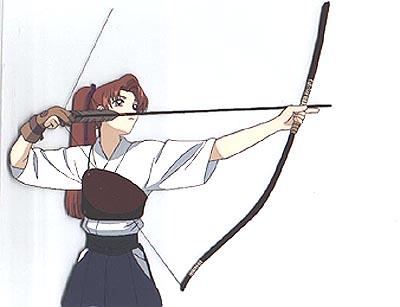
Kai
(Full draw of the bow)
After daisan (first draw), the left hand pushes forward and the right arm pulls back simultaneously. Most of the draw occurs in the left hand which seems counter-intuitive. The right hand moves across the forehead and around the ear to full draw. The arrow should rest just below the archer's nose. In fact, the archer's body is partially within the draw of the bow. The only thing that keeps the bowstring from hitting the body is that, if correctly done, the bowstring will swing around counterclockwise upon release. The string would then face the target.Kai is the last step before the release of the arrow.
Here's an example:

From the same sequence as daisan. She has not fully extended her draw but is on the way to full kai. The arrow, however, should be parallel to the floor and her head should not be looking up as it is. You probably don't get a sense of the largeness of the draw from this picture. Recall that the bow extends another couple feet above her head and maybe you can visualize it.It's hard to discuss kai without moving on to the next step, hanare (release), because there's no rule when one should end and the other begin. Holding kai is extremely difficult. The body begins to shake from the effort after only a little time. It's the moment of greatest tension in the entire process and the one of the most danger for the archer and for others.
Go to next step: hanare
Return to Kyudo page
E-mail me with comments at [email protected]Last Updated: August 15, 2000